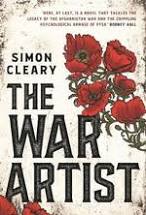Brisbane author Simon Cleary’s previous novels The Comfort of Figs and Closer to Stone are fine works, but I think his latest release The War Artist (UQP 2019) might be his most accomplished yet. This story had me gripped from beginning to end. I’m not sure what I expected (a war story?) but my expectations were upturned and exceeded with this tale of love, betrayal, sacrifice, forgiveness and trauma.
The War Artist is ostensibly about the crippling psychological effects of PTSD, particularly as associated with soldiers returning from the war in Afghanistan. Brigadier James Phelan witnesses the shocking death of a young soldier and accompanies the man’s body home to his family. Traumatised and unmoored, he visits tattoo artist, Kira, on a whim, to have the man’s name permanently marked on his body. His encounter with Kira leaves him confused and unsettled. He returns to Brisbane not as a hero, but to a barrage of blame for the young soldier’s death, and a campaign of retaliation by the other surviving soldiers from his unit. With his career threatened, and his marriage to wife Penny strained by the stress, his life unravels into a knotty mess. And when, years later, Kira (along with her young son) seeks him out to ask for his help as she flees from her own troubles, Phelan is forced – finally – to confront the demons of his past, to atone for his actions and to assuage his guilt.
I suppose I expected this book to be about war – and in many ways, it is: it’s about the terrible damage inflicted on young minds forced to fight brutal and often incomprehensible battles; it’s about group mentality and survivor guilt and pack behaviour; it explores the horrific effects of PTSD and the mental anguish suffered by many returned servicemen and women; it doesn’t shy away from the physical scars of war – the damaged bodies and amputated limbs; it examines the bureaucracy and government of war; it emphasises the unbreakable bond that returned soldiers share after a deployment.
But this book is about so much more than that. This is an incredible love story – James and Penny, unable to have children, much of their life dedicated to service – are strained almost to breaking point by the effects of his war experience, and yet they survive, and this book is homage to that kind of love, to that inner strength and complete respect and responsibility for the person that is your life partner. Conflict, mental health problems, infidelity and ego all plague this couple; watching their lives hang together by the thinnest of threads through it all is a compelling journey.
The novel explores other kinds of love, the love of friendship and mutual grief, the love of a parent for a child, the love of comrades with whom the most intimate experiences have been shared.
This is also a book about art. Tattooing is a special kind of remembrance, a permanent mark of respect or love or possessiveness or memory or achievement. The psychology behind tattoos and their meanings is at the heart of this novel, and the way tattooing is used in the second half of the story – to commemorate, to honour – is such a beautiful and mesmerising process. Pain delivers relief. Memory vanquishes distress.
The research into people and places that has gone into the book is obvious. The characters are all finely-drawn, the complicated dynamics between them explored with sensitivity and grace. The examination of setting – the landscape and environment of both Queensland and Afghanistan – is done with a keen eye for small details, and a true feeling for place. And out of all of this rises the plot, sharp as a knife-edge. Uncertainty looms large – we are never sure what is going to happen to these characters, or how, or when. Cleary very cleverly allows the reader to know (or to suspect) secrets that some of the characters themselves don’t know, and this engages us in a deliciously complicit waiting game of suspense and tension. Especially towards the end of the book, there are several possible bad outcomes – any of which could happen – and we are drawn inexorably along to the edge of the cliff, unable to stop or turn away, hoping for the best but fearing the worst. The ending is ambiguous enough to keep us thinking but satisfying enough to allow us to take a well-earned breath. This is great fiction indeed, the kind that feels authentic, transporting and true.

